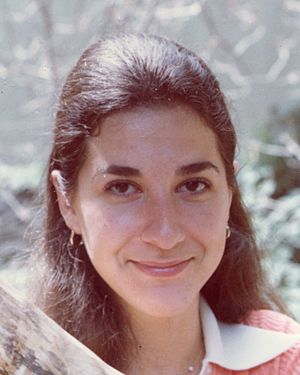Jill P. Mesirov facts for kids
Quick facts for kids
Jill Mesirov
|
|
|---|---|
 |
|
| Born |
Jill P. Mesirov
|
| Alma mater | University of Pennsylvania (BA) Brandeis University (PhD) |
| Awards | ISCB Fellow (2012) |
| Scientific career | |
| Institutions | University of California, San Diego Broad Institute Boston University |
| Thesis | Perturbation theory for the existence of critical points in the calculus of variations (1974) |
| Doctoral advisor | Richard Palais |
Jill P. Mesirov is an American scientist who works with computers to solve big problems. She is a mathematician, a computer scientist, and a computational biologist. This means she uses computer science and math to understand biology.
Currently, she is an important leader at the University of California, San Diego. She helps guide how computers are used to study health. Before this, she worked at the Broad Institute and Boston University.
Education and Learning
Jill Mesirov went to the University of Pennsylvania for her first degree. After that, she studied at Brandeis University. In 1974, she earned her PhD in mathematics there. Her teacher was a famous mathematician named Richard Palais.
Her Work and Career
Jill Mesirov's work is all about high-performance computing. This means using very powerful computers to do complex calculations quickly. These computers can help solve huge scientific problems.
Since 2015, she has been a top leader at the University of California, San Diego School of Medicine. She is an Associate Vice Chancellor for Computational Health Sciences. She also teaches as a Professor of Medicine. Her work helps connect computer science with health studies, especially in areas like cancer research at the Moores Cancer Center.
Over the years, she has worked at many important places. These include the University of California, Berkeley, IBM, and the Broad Institute. She was also the president of the Association for Women in Mathematics from 1989 to 1991. This group helps support women in math.
Awards and Special Honors
Jill Mesirov has received many awards for her important work.
- In 1996, she became a fellow of the American Association for the Advancement of Science. Being a "fellow" means you are recognized as a top expert in your field.
- In 2012, she was chosen as an ISCB Fellow by the International Society for Computational Biology.
- She also became one of the first fellows of the American Mathematical Society in 2012.
- In 2017, she was honored again as a fellow of the Association for Women in Mathematics. This was part of their very first group of fellows.
These awards show how much her work has helped advance science and computer technology.

